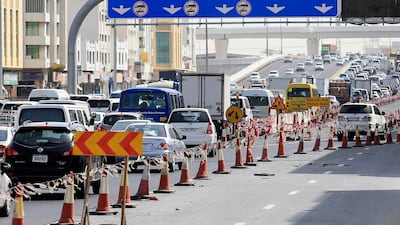Cutting traffic congestion between Sharjah and Dubai and improving transport links to the north is the key focus of a new transport masterplan.
The move by the transport bodies of different emirates is part of a drive aimed at providing smoother travel throughout the road network, said Ahmed Al Hammadi, director of the Federal Roads Department.
“We will start to have a full masterplan for the UAE highway and road network in the beginning of 2018,” Mr Al Hammadi said on the first day of a three-day Gulf Traffic conference in Dubai on Monday.
“We have a big team and we are talking with all the authorities who deal with roads and traffic of the other emirates. We are trying to have one vision and one goal for the UAE to develop the networks with full coordination, to deal with traffic and to implement the latest techniques for the UAE.”
The ministry is responsible for highway routes particularly in the northern emirates of Sharjah, Ajman, Ras Al Khaimah, Umm Al Quwain and Fujairah.
Among major projects to ease traffic between Dubai and Sharjah is the Dh200million Maliha Road interchange bridge project on Emirates Road.
Work on the seven-lane bridge to handle an estimated 17,700 cars per hour is on track for completion in August 2018.
“About 60 per cent of the work is done. The interchange will have free flow from all directions,” Mr Al Hammadi said.
Motorists have complained about the bottleneck on Emirates Road near the Maliha intersection since six lanes from Dubai drop down to two-to-three lanes.
With the new project, a nine-lane approach road will lead to the seven-lane bridge.
Extra lanes will be provided well ahead leading to the exits to prevent sudden lane changes.
“Now there are three lanes but in the future, it will be more than nine lanes, some will go to Sharjah, some will go to Fujairah and to Ras Al Khaimah so it will help decrease the rush.”
Once finished in the third quarter of next year, the massive bridge will cut travel time and divert traffic away from Sheikh Mohammed bin Zayed road and Al Ittihad Road.
Emirates Road is a vital corridor linking the north to the south and expansion is vital to decreasing traffic jams into Dubai and Sharjah near the Maliha road exit.
Experts welcomed coordinated schemes to improve road capacity.
“People who work in Dubai and Abu Dhabi and live in Sharjah spend a lot of time on the road and congestion leads to stress-related behaviour, and that is likely to cause incidents and collision," said Britta Lang, technical director at 4E Road Safety and Transport Consultants.
__________
Read more
Road works to ease traffic woes between Dubai and Sharjah
Road safety campaign aimed at lane discipline
__________
The Maliha Road expansion through to Kalba will be completed by February, Mr Al Hammadi said.
The first stage of the extension of the Khalifa bin Zayed road with work launched in Kalba through to the Oman border will be completed by the year-end.
Safety was also the focus of the Ministry of Infrastructure with a two dot system painted on a road in Umm Al Quwain this year to help motorists understand the need for a 62-metre distance between cars. Sign boards were also placed cautioning motorists to keep “safe distance of at least two dots.”
A similar initiative will be implemented on the Maliha road in Sharjah as part of a broader aim to reduce road fatalities in the country.
The campaign was similar to visual safety projects overseas.
“This is an excellent idea because it provides a visualisation for the driver of the safe distance,” Ms Lang said.
“As humans we are not particularly good at perceptual processes at speed, so having a visual anchor on the road allows us to make the judgment of how close we are to the vehicle in front. Any visual marker on the roads that helps people to better assess the distance from the vehicle in the front is a good thing.”


